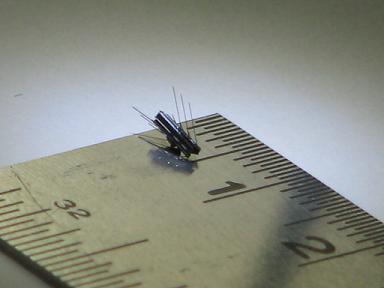The tiny submarine, the result of a collaboration between Technion researchers and a researcher from Judea and Samaria College in Ariel, will enable autonomous movement and medical treatment inside the human body
In the picture: the "submarine" which will move in the body's canals
Technion researchers, in collaboration with a researcher at Judea and Samaria College in Ariel, developed a tiny "submarine" that could move through the body's canals. In recent years, researchers around the world have been trying to develop a robot that would be small enough and capable of remote controlled independent movement that would in turn enable medical treatment with minimal damage to the patient's tissue.
"For the first time, a tiny robot was designed and built with the unique ability to crawl through pipes in a wide range of diameters that characterizes veins and arteries in the human body," explains Dr. Nir Shvalev, a researcher from Yosh College. "The robot will be able to crawl under a counterflow of blood with the strength typical of blood vessels in the body without any problem, something that has not been possible until now."
Oded Salomon, a researcher at the Medical Robotics Laboratory in the Faculty of Mechanical Engineering at the Technion, adds: "The achievement is in the unprecedented miniaturization and the ability to control the operation of the robot for an unlimited period of time in any medical procedure to which it is attached. The power source of the robot is an external magnetic field induced near the patient. Such a field lacks any effect on the human body on the one hand and enables energy supply and control over the robot on the other hand. The special structure of the robot allows controlled movement thanks to a magnetic field induced on the robot."
The researchers point out that a team of scientists from Kyoto University in Japan is developing a robot that will allow independent movement inside the human body, but according to them its size in relation to the typical sizes of channels in the human body will not allow it to move inside veins, for example. The diameter of the Israeli robot amounts to approximately one millimeter, while its Japanese counterpart has a diameter of one centimeter.
"Medicine is going to be much more focused and the demand to reach exactly the goal will only increase", emphasize the Israeli researchers. "The academic world is trying to develop a robot that will be small enough to move in the small spaces of the body and at the same time have navigation capabilities that will allow complex medical operations," adds Professor Moshe Shoham of the Technion, who is a partner in the research. Professor Shoh has previously developed the robot of the "Mazor" company, which is currently used in many hospitals around the world to perform spine surgeries.
The "submarine" is built as one central structure and from it stretch tiny arms that enable a firm grip on the side of the pipes. Each oscillation allows the robot to move forward a little and the unique structure of the hairs allows movement in a wide range of locomotives.
The body channels are not uniform in diameter, so it is very important to be able to grip a wide variety of diameters. It is too early to assess which medical procedures the robot will be used for, but the researchers point to a number of possible directions. "Among the visible possibilities we will mention a medical procedure called Brachytherapy. This is a targeted procedure for the treatment of cancer that is currently performed at the end of a surgical operation in which a drug is injected into the patient's body. Using the robot, the doctor will be able to transport the medicine and it will be released in the intended place, without unnecessary pain and with maximum accuracy. In addition, a significant advantage that is currently visible, is the use of several tiny robotic units, for simultaneous intervention and controlled treatment in a large number of cancer foci."
Professor Shaam emphasizes that this is an interesting development, but there is still a long way to go until its implementation.


One response
Nanotechnology in healthcare.
For more information on the series of health products that operate according to the nano-technological principle, please visit the website:
http://www.basketb.ws